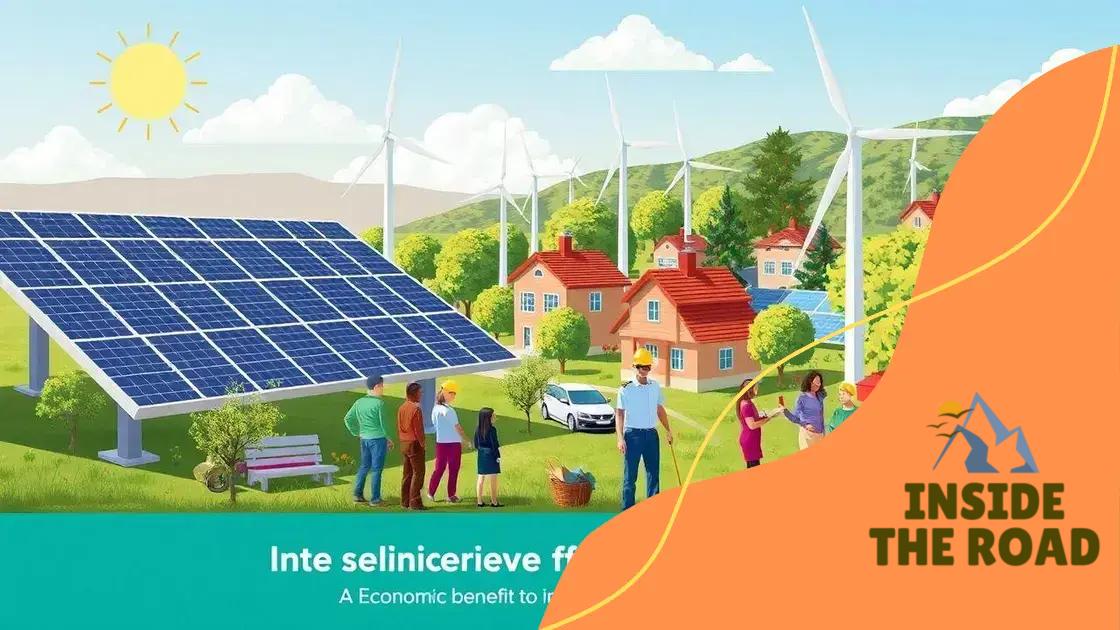Advances in renewable energy tech and their economic impact

Advances in renewable energy technology are driving job creation, improving energy efficiency, and promoting economic growth while facing challenges like intermittency and regulatory barriers.
Advances in renewable energy tech are not just changing how we generate power; they’re shaping our economy in profound ways. From job creation to sustainability, these developments invite curiosity about their implications for our future. Let’s dive into the details.
Key innovations in renewable energy technologies
Key innovations in renewable energy technologies are transforming the way we produce and consume energy, driving us towards a more sustainable future. Each breakthrough reshapes our approach to energy consumption and accessibility.
Advancements in Solar Power
Solar power is continuously evolving, making it more efficient and affordable. Technologies like solar panels have seen significant improvements, with new materials enhancing their effectiveness. For example, the use of perovskite solar cells is a game-changer, with the potential to double the efficiency of traditional silicon cells.
- Higher efficiency rates
- Lower manufacturing costs
- Flexible solar technologies
- Integration with smart grids
Wind Energy Innovations
Similarly, wind energy is harnessing the power of advanced technology. The development of offshore wind farms allows for larger turbines that capture more wind energy. These innovations result in a cleaner and cheaper energy source.
The push towards larger, more efficient turbines is essential for increasing the capacity of wind farms. New floating turbine designs are also enabling deployment in deeper waters, where winds are stronger. These developments are encouraging many countries to invest more heavily in wind energy, contributing to national energy goals.
Battery Technologies
Another critical area of advancement is in battery technology. As renewable energy sources like wind and solar are intermittent, energy storage becomes vital. Innovations in lithium-ion batteries, such as improved longevity and faster charging, are making it possible to store renewable energy more effectively.
- Longer battery life
- Quicker charging capabilities
- Lower costs
- Environmental sustainability
Many companies are now researching solid-state batteries, which promise even greater safety and energy density. This ongoing development is crucial for supporting electric vehicles and renewable energy storage, ultimately driving further adoption of clean energy.
As these innovations unfold, they not only enhance efficiency but also create new job opportunities across various sectors. The transition to renewable energy technologies is paving new avenues for economic growth, highlighting the interconnectedness of energy innovation and economic development.
How renewable energy impacts job creation
How renewable energy impacts job creation is a crucial aspect of transitioning to a sustainable economy. As industries shift towards cleaner energy sources, new job opportunities arise, benefiting communities and boosting local economies.
Growth in Renewable Energy Sectors
The renewable energy sector is rapidly expanding, offering a wide range of employment opportunities. For instance, jobs in solar and wind energy are growing faster than most traditional energy sectors. These industries require skilled workers for various roles, from engineering to installation.
- Increased demand for engineers and technicians
- Jobs in manufacturing renewable energy technologies
- Roles in installation and maintenance of equipment
- Growth of research and development positions
Economic Benefits of Local Job Creation
Job creation in renewable energy can stimulate local economies. When new projects start, they not only hire workers but also support local businesses. Workers in this sector often spend their income in their communities, further enhancing economic growth.
Moreover, these jobs tend to be more stable and offer good wages. For many areas, transitioning to renewable energy can be a pathway to reduce unemployment and increase the quality of life.
As governments and organizations invest in renewable technologies, the associated job creation tends to rise. This surge not only helps reach energy goals but also uplifts entire communities by providing opportunities for education and skills training in new energy technologies.
Training and Education Opportunities
With the growth of the renewable energy sector comes a need for training programs. Colleges and vocational schools are increasingly offering courses focused on renewable energy technologies. These programs aim to equip students with the relevant skills needed to thrive in the job market.
- Hands-on training in solar panel installation
- Workshops on wind turbine technology
- Certification programs for energy efficiency
- Curriculums focusing on sustainable practices
The emphasis on education ensures that the workforce is prepared for emerging technologies. As a result, workers are well-equipped to fill positions in this growing field, ultimately leading to a stronger economy.
Economic benefits of investing in clean energy

Economic benefits of investing in clean energy extend far beyond environmental impacts. As nations shift toward greener technologies, they unlock significant financial opportunities that support both growth and sustainability.
Job Creation and Economic Growth
Investing in clean energy leads to job creation in various fields. New projects in the renewable sector demand skilled workers, which helps reduce unemployment rates. Many roles can arise, such as engineers, technicians, and construction workers specialized in renewable energy technologies.
- Increased demand for local labor
- New engineering and research positions
- Expansion of manufacturing jobs
- Opportunities in project management
Lower Energy Costs Over Time
Investments in clean energy often result in lower energy costs for consumers and businesses. In the long run, renewable energy sources like solar and wind have low operating costs. As technology improves, prices continue to decline.
Government incentives also play a vital role in promoting clean energy usage. Tax credits and subsidies encourage businesses and households to invest in renewable energy systems, resulting in more affordable energy for everyone.
Enhancing Energy Security
By investing in clean energy, countries can enhance their energy security. Relying on local and renewable sources reduces dependence on imported fossil fuels, making economies less vulnerable to price fluctuations and supply disruptions.
- Stability in energy supply
- Reduced exposure to international market volatility
- Increased energy independence
- Protection against geopolitical tensions
Furthermore, clean energy investments foster innovation and technological advancements. As businesses and governments work together, new solutions emerge, pushing economies towards greener practices while maintaining growth.
These investments yield both short-term and long-term benefits, showing that the shift to a cleaner energy future is not only necessary for the planet but also advantageous for economic prosperity.
Challenges faced by the renewable energy sector
Challenges faced by the renewable energy sector are important to understand as countries transition to cleaner energy. While renewable energy offers many benefits, it also encounters several obstacles that can hinder its growth and effectiveness.
Intermittency of Energy Sources
One major challenge is the intermittency of renewable energy sources. Solar and wind power are dependent on weather conditions and daylight. During cloudy days or calm periods, energy generation decreases, leading to reliability issues.
- Energy production is less predictable
- Storage solutions are needed for consistent supply
- Need for backup energy systems
- Investment in grid infrastructure
High Upfront Costs
Although renewable technologies often save money over time, the initial investment can be high. Purchasing and installing solar panels or wind turbines requires significant capital. This can discourage businesses and individuals from making the switch.
Government incentives and financial support can help alleviate this burden. When financial barriers are lower, more people are likely to adopt renewable energy solutions.
Regulatory and Policy Barriers
Government policies play a crucial role in the growth of the renewable energy sector. Regulatory hurdles can slow down the adoption of clean technologies. Inconsistent policies can create uncertainty for investors and businesses.
- Need for clear and stable regulations
- Streamlining permitting processes
- Addressing zoning laws
- Encouraging public-private partnerships
Moreover, some regions may prioritize fossil fuels over renewables due to established interests, making it harder for clean energy to compete. This lack of political will can limit advancements in renewable energy deployment.
Finally, public awareness also influences the renewable energy landscape. Many individuals and organizations are still unaware of the benefits or possibilities of renewable energy. Educational initiatives can help bridge this gap and boost acceptance.
Future trends in renewable energy technology
Future trends in renewable energy technology are shaping the landscape of how we will harness and use energy. As technology advances, several exciting developments are on the horizon that could significantly impact the global energy market.
Advancements in Energy Storage
One key trend is the improvement in energy storage solutions. As renewable energy sources like solar and wind are intermittent, efficient storage systems are essential. Technologies such as lithium-ion batteries and emerging solid-state batteries are paving the way for better energy management.
- Longer battery life and increased capacity
- Faster charging technologies
- Enhanced safety and durability
- Cost reductions in battery production
Smart Grids and IoT Integration
Another trend is the evolution of smart grids, which utilize Internet of Things (IoT) technology. Smart grids enable real-time monitoring and management of energy use, allowing for more efficient distribution and consumption.
With IoT, devices can communicate and optimize energy usage, making households and businesses more energy-efficient. This integration empowers consumers, giving them greater control over their energy consumption and costs.
Emerging Renewable Technologies
As research continues, new renewable technologies are being developed. Innovations such as floating solar panels and advanced wind turbine designs promise to increase energy production in previously unusable spaces.
- Floating solar farms on water bodies
- Vertical-axis wind turbines for urban areas
- Bioenergy advancements in agriculture
- Hydrogen fuel cells for clean energy
These emerging technologies could revolutionize the renewable landscape, allowing more locations and scenarios to utilize clean energy, thus reducing our carbon footprint.
In conclusion, the future of renewable energy technology is bright, with innovations that promise to enhance storage, manage consumption better, and introduce new renewable sources. Investing in these advancements is crucial for a sustainable energy future.
FAQ – Frequently Asked Questions about Renewable Energy Technology
What are the main benefits of renewable energy?
Renewable energy reduces dependence on fossil fuels, lowers greenhouse gas emissions, and can create jobs while promoting sustainable economic growth.
How does energy storage technology impact renewable energy?
Energy storage technology allows for the management of energy supply during periods of low generation, helping to ensure a constant energy supply from intermittent sources like solar and wind.
What challenges does the renewable energy sector face?
The sector faces challenges such as intermittency of energy supply, high upfront costs, regulatory barriers, and the need for public awareness and education.
What future trends should we expect in renewable energy technology?
We can expect advancements in energy storage, smart grid technology, and new renewable solutions, such as floating solar panels and enhanced wind turbine designs.






